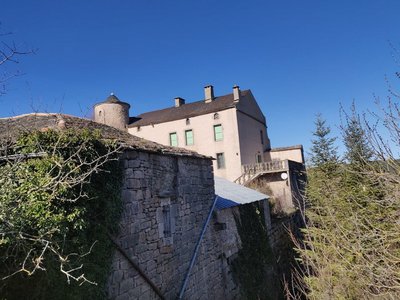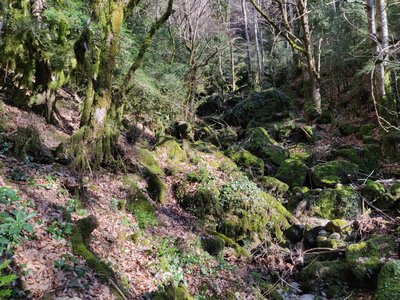
Le Pas de l'Ane
A long time ago, that donkey took a wrong step (“pas de l’âne” means “donkey step”) and fell off the cliff with its unlucky owner…
3 points of interest

La place du village - Béatrice Galzin  History
HistoryTrèves
From Tabrî, meaning “village close to the water” in the Chasséen culture (Baume Lairoux, La Verrière, etc.), which lay on the trade route between the Gabali tribe, the coast and the Arecomici tribe. It was given a wooden bridge by the Romans, occupied first by Arian Visigoths and then by Nicene Christian Franks, and destroyed by Muslims around 730. It was revived in the Carolingian period with its Romanesque bridge, and was loyal to the Kings of France, who granted it a consuls’ charter in the 14th century and the bell on top of the church, which had remained Catholic. In the 17th century, Trèves had hemp fields, whose hempen cloth was used in the draperies in Lodève. Its blue sheep’s cheese, its galena mine and its terraces of almond trees and lentils belong to the past. Only the Pétassou (local pagan character and festival) remains (M.MOULINIER, historian).
Le château - Béatrice Galzin  History
HistoryEspinassous and its castle
This is the Espinassous plateau with its 15th century castle. It only has one tower; the second tower allegedly imitated that donkey and fell into the ravine on whose edge it stood.
The castle courtyard with its former farm outbuildings is magnificent; you can see them through the bars of the gate. These buildings are typical of Causse architecture: heavy limestone roofs, facades flanked by buttresses, narrow openings in the pointed barrel vaults.
The hamlet is in an agricultural plain near the cliff’s edge.
Le ravin sans nom - Béatrice Galzin  Natural environment
Natural environmentTropical forest and the Causse flora
The Causse vegetation is very different from that on the valley floor of the “ravine with no name”.
On the Causse with its dry limestone soil grow pale flowers, such as the blue/mauve liverwort or the white wood anemone. A yellow spot is a California buttercup, without forgetting the thyme which perfumes the path!
Boxwood lines both sides of the path. Downy oaks and Scots pine give some shelter in summer. The “ravine with no name” is a total change of scene. All of a sudden, you find yourself in a dense tropical forest; boxwood and lianas share the ravine. The sun never pierces the plant cover to warm the stream – never! It is chilly down here.
Moss grows everywhere. Luckily the waymarking is perfect.
Description
Start in Trèves, on the car park in front of the mairie. Take the path uphill to the cross.
- There are several hairpin bends to reach the signpost “Roc du regard”: go to the viewpoint.
- At “Roc du regard”, turn left; make sure to close the barrier.
- Continue on the path. At the lane “Le puech”, go right towards "Mare d'Espinassous" and the hamlet.
- Walk through the hamlet of L'Espinassous and continue straight ahead.
- At the signpost "Mare d'Espinassous" turn right and go downhill to “Randavel”, then to the D157.
- Turn right onto the road for about 800 m.
- Turn left and cross the bridge over the Trévezel river. Continue on the road towards Comeiras.
- In the 4th hairpin bend, leave the road and go straight – close the barrier.
- Continue on the path to a level area.
- Difficult downhill section among the rocks: slippery path.
- At "La Sourdette" go back up towards “Hameau du Villaret” and from there downhill to “Trèves” via "La vierge". Cross the village uphill to the mairie.
- Departure : Trèves – mairie (town hall)
- Arrival : Trèves – mairie (town hall)
- Towns crossed : Trèves, Lanuéjols, and Dourbies
Forecast
Altimetric profile
Recommandations
Information desks
Tourism & national parc'house
Col de la Serreyrède, 30570 Val d'Aigoual
The Maison de l'Aigoual houses the tourism office Mont Aigoual Causses Cévennes and the Maison du Parc national. This visitor centre provides information on and raises awareness of the Cévennes National Park, its sites and events as well as the rules that must be observed in the National Park's central zone.
On site: changing exhibitions, video projections, Festival Nature events and shop Open year-round
Transport
(in term time)
Access and parking
Parking :
Calculateur d'itinéraire Lio
Utilisez le calculateur liO pour organiser votre trajet en région Occitanie.
Autres régions
Calculez votre itinéraire en Auvergne Rhône Alpes sur Oùra
Biodiversité autour de l'itinéraire
Source

Report a problem or an error
If you have found an error on this page or if you have noticed any problems during your hike, please report them to us here:

